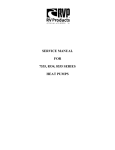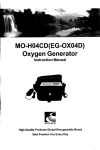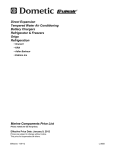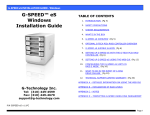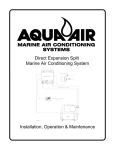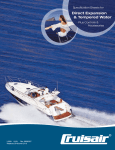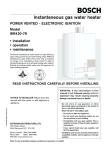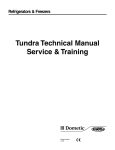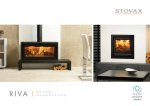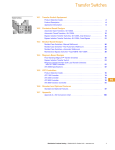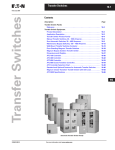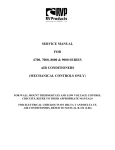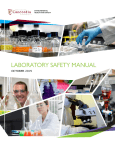Download Cruisair DX Operating instructions
Transcript
DX Built-In Air Cooled A/C Systems v INSTALLATION • OPERATION 2 Distributed By: P.O. Box 430 Milford, VA 22514 Phone (804) 633-9454 FAX (804) 633-5499 DIRECT EXPANSION SYSTEMS Dometic Corporation 2000 N. Andrews Ave. Ext. • Pompano Beach, FL 33069-1497 USA Phone: 954-973-2477 • Fax: 954-979-4414 Website: www.dometic.com/marine • Email: [email protected] Revised: 20140404 L-0261 For LP-10A WARNING This manual contains essential safety information concerning the safe and proper installation of Cruisair direct expansion air conditioning systems. It is very important that you read and understand the contents of this manual thoroughly before attempting to install any Cruisair equipment. If there are any statements in this manual that you do not understand, contact the Dometic Applications Department for assistance. Phone 954-973-2477, Fax 954979-4414 (8:00 am - 5:00 pm United States EST). NOTICE As of July 1, 1992, United States federal law As of July 1, 1992, United States federal law prohibits the intentional release of refrigerant gases into the environment, including the R-22 refrigerant used in Cruisair air conditioning systems. Special care must be taken when installing, charging and servicing Cruisair equipment to prevent any loss of refrigerant. Cruisair does not recommend the practice of using refrigerant to purge air and moisture from the system at installation. This formerly used practice of purging is in violation of United States federal law. INTRODUCTION This manual covers installation procedures for Cruisair direct-expansion air conditioning systems. In addition, there are specific installation sheets for some models which may be shipped with Cruisair air conditioning equipment, providing additional details for specific components. 2 Table of Contents Chapter 1: Description of Basic Components............................................................................................4 Basic Principles...............................................................................................................................4 Cooling Unit.....................................................................................................................................4 Controls/Switches............................................................................................................................4 Condensing Unit..............................................................................................................................4 Figure 1. SA 3 Series Control..........................................................................................................4 Figure 2. SMX Series Keypad.........................................................................................................4 Chapter 2: Installation of Basic Components.............................................................................................5 Cooling Unit.....................................................................................................................................6 Control or Switch Assembly.............................................................................................................6 Condensing Unit..............................................................................................................................6 Installation Kit..................................................................................................................................7 Figure 3. Minimum Grill and Free Air...............................................................................................5 Figure 4. Diagram of Flared Joint....................................................................................................7 Figure 5. Refrigerant Line Sizes......................................................................................................8 Chapter 3: Start-Up Procedures - Final Inspection....................................................................................9 Figure 6. Wire and Breaker Size......................................................................................................9 Chapter 4: Start-Up Procedures - Initial Charging of A New System.......................................................10 Required Tools...............................................................................................................................10 Field Charging a System............................................................................................................... 11 Removing Refrigerant from a System............................................................................................ 11 Figure 7a. Charging Pressure Charts for Equipment Built in 1994 and After.................................12 Figure 7b. Charging Pressure Charts for Equipment Built Prior to 1994........................................13 Chapter 5: Start-Up Procedures - Final Check-Out and Start-Up............................................................14 Chapter 6: General Operation.................................................................................................................15 Operating Instructions - Rotary Knobs..........................................................................................15 Operating Instructions - SMX Series Controls..............................................................................16 Chapter 7: Maintenance..........................................................................................................................17 Cooling Unit and Switch Assembly................................................................................................17 Condensing Unit............................................................................................................................17 Chapter 8: System Failure Troubleshooting Guide...................................................................................18 Chapter 9: System Charging Troubleshooting Guide...............................................................................19 Chapter 10: Installation Wiring Diagrams.................................................................................................20 Index of Diagrams.........................................................................................................................20 Warning...................................................................................................................................................31 3 CHAPTER 1: Description of Basic Components Basic Principles SA type switch assembly has rotary knobs for controlling the system. Figure 1 shows a typical SA switch assembly. The Cruisair air conditioning system consists of three basic components and, in some cases, several accessory parts. They are: (1) cooling unit; (2) control or switch assembly; and (3) condensing unit. This instruction manual will describe and explain the function of the basic parts of a Cruisair system and will outline the installation, interconnection and startup of a complete system. It also includes maintenance and operation of Cruisair equipment in general. The SMX series controls are advanced microprocessor based systems, with more than 20 user programmable functions. These functions are described in the SMX series owner’s manuals. Figure 2 shows an SMXII control panel. Cooling Unit The cooling unit is a refrigerant to air heat exchanger coupled to a fan or blower which is located in the space to be cooled. A cooling unit is sometimes referred to as an ‘evaporator’ or a ‘cooling coil’, but in this manual, we will use the term ‘cooling unit’. The cooling unit is constructed of a series of copper tubes held in place by vertical aluminum fins. Inside these tubes, the refrigerant expands to produce a chilling effect by absorbing the heat in the air. This air is forced through the coil by the fan or blower. Cooling Down 77 Set Inside Heating Up Outside Temp Cool Off Heat Manual Mode Slow Fan Fast Controls/Switches There are two basic types of controls and switches used with Cruisair systems: the SMX series of microprocessor controls and the SA family of rotary knob switch assemblies. The Figure 2. SMX Series Keypad Filename: Fig2.EPS Illustrator Condensing Unit 7.0 10-28-97 Font: .047 pt. The condensingHelvetica, unit consists of the Line weight:the .5refrigerant refrigerant compressor, receiver, the refrigerant to air heat exchanger or condenser, condenser fan or blower, the associated electrical components, and the system service valves. The basic function of the condensing unit is to compress the expanded refrigerant, flowing back from the cooling unit to the compressor, to a high pressure state. The compressed refrigerant then passes through the heat exchanger (condenser coil) where it gives up the heat which was absorbed in the cooling coil. It is then condensed to a liquid state as it flows to the liquid receiver and the process of flow back to the cooling unit is repeated. Figure 1. SA 3 Series Control 4 CHAPTER 2: Installation Of Basic Components Centrifugal or blower type cooling units, model number prefixes EBS, EBO, EHBO, EBL or EHBL, should be mounted low, near the return air grill, and the discharge air ducted to the discharge grill mounted at a high level. The following instructions should be followed, in their proper sequence, when installing Cruisair equipment. Read and understand the instructions in this manual before proceeding. Cooling Unit In all installations, the cooling unit must be installed so the air discharge grill is installed as high as possible, (minimum three feet above the floor level). The cooling unit must be installed with the condensate drip pan positioned at the bottom of the unit so the water dripping from the evaporator coil collects in it before discharging to a suitable drain outside. The cooling unit drain must be installed so the drain tube makes an immediate 1” drop after leaving the drain fitting. The cooling unit must be installed so there is an adequate path for the air to re-circulate freely into the unit from the space being cooled. It is important that the cross sectional area of all discharge grills be at least equal to the coil face area of the discharge of the cooling unit involved. An exception is the centrifugal blower type cooling unit. The cross sectional area refers to the ‘free air’ area of a discharge air grill rather than the total area as determined by the overall measurement of the grill itself. For instance, if a grill is made of expanded metal, perhaps only 50% of the area is open for the passage of air. The metal web itself will block air from passing through the other 50%. In such cases, the total area of the grill must be doubled to achieve the required open area. Observe this carefully when selecting a grill. With discharge air grills located high, return air grills should be located as close to the floor as possible to provide the best pattern of air flow. Avoid locating the return air grill in close proximity to the discharge grill since the resulting short circuiting effect of the air flow will impair the effectiveness of the system. Cooling units with model number prefixes EFB, EBH, or EFL should be mounted as high as possible, directly behind the discharge grills. The return air grills used should be the type which have removable filters so they Minimum Grill And Free Air Area EVAPORATOR DUCT GRILL AREA FREE AIR AREA Type BTU’s Size In. Return (Sq. In.) Supply Return (70%) (Sq. In.) Supply (60%) EBL EBO EBS EFB EBH EFL 16,000 4,000 7,000 10,000 14,000 16,000 14,000 16,000 10,000 14,000 16,000 14,000 16,000 1,000 14,000 16,000 2 @ 5 4 5 6 7 7 7 7 NA NA NA NA NA NA NA NA 144 64 72 100 144 144 144 144 100 144 144 144 144 40 128 128 Figure 3. Minimum Grill and Free Air 5 2 @ 49 32 49 60 80 80 80 80 100 144 144 144 144 40 128 128 101 45 51 70 101 101 101 101 70 101 101 101 101 28 90 90 2 @30 19 30 36 48 48 48 48 60 87 87 87 87 24 77 77 Condensing Unit can be removed and cleaned easily. The filter material should be a type which will not cause a significant inlet air flow pressure drop. For all discharge air applications, wood or plastic frames are recommended. Aluminum frame grills will become cold and may produce secondary condensation that will drip from the grill frame. Cruisair condensing units are designed to be installed in a compartment ventilated to the outside. Air entry and exit openings to the exterior should be protected by rain proof louvers or grills. Space should be provided on all sides of the unit to allow air to enter it for cooling the condenser. All refrigeration components are hermetically sealed and all electrical components are spark proof for maximum safety. Make sure the wood base is positioned at the bottom of the unit in a horizontal plane. Fasten the condensing unit wood base securely and in such a way that the unit can be removed for service if necessary. See Figure 3 to determine the minimum grill and free air areas for each model cooling unit. Control or Switch Assembly The control or switch assembly is supplied as a separate item. The rotary switch assembly has three knobs and the plate is printed either for horizontal or vertical installation. It is designed to be mounted in an opening cut on the job and is fastened from the front with four screws. The wiring from the switch assembly terminates in a color coded terminal strip that should be securely mounted in a suitable place. Electrical connections for all systems are typically the same. ACA Series Condensing Units Return Air Operation of the SA type controls is covered in Chapter 6. The thermostat in the switch assembly has a 10 foot capillary tube leading from it to the temperature sensing bulb. This bulb must be located in the system’s return air stream so that the bulb is exposed only to the air returning from the space being cooled. The SMX control system uses a Temperature Sensing Element (TSE) to control the operation of the system. Like the thermostat bulb on the SA type control, this TSE must be installed in the return air path of the conditioned air. These sensors are available in various lengths from 10 to 80 feet. Operation of the SMX type controls is covered in the SMX Series Control Systems User’s Guide, L-634. 6 Minimum Grill Area 240 sq. in. Free Air (70%) 168 sq. in. Installation Kit 1. Copper Tubing When installing the two connecting copper tubes between the cooling unit and the condensing unit, there are several important factors to consider. First, the tubing can be run in lengths up to 50 feet. It can run uphill, downhill, or sloping, as required and can have as many bends as necessary. (Avoid sharp bends and do not use soldered elbows.) Both the suction and discharge lines should be insulated individually to prevent moisture from forming on the tube and for vibration protection. Also insulate the connecting flare nut joints carefully to prevent dripping of moisture from these joints. Figure 4. Diagram of Flared Joint Caution • • • • • • • • • • • • • • Always use refrigeration grade, seamless, soft copper tubing. Never use neoprene, rubber or any other type hose not designed specifically for use with R-22 and approved by Cruisair. The refrigerant used in Cruisair systems is monochlorodifluoromethane or R-22. This gas is compatible with very few tube compositions with copper being the most frequently used. (Engine driven systems use a different type refrigerant so therefore can use a neoprene refrigerant lines.) The copper tubing is connected to the cooling unit and condensing unit with flare joints. Flares of exceptional quality are essential to prevent refrigerant leaks. Flares must be of the 45°, single flare type. Do not use a double flare. The flare should be large enough in diameter to fill the flare nut completely. See Figure 4. Only the long stem forged flare nuts, such as those that are supplied with Cruisair equipment, are strong enough for mobile duty. Do not use long stem machined flare nuts. Flare nuts should be tightened until the nut ceases to offer resistance to tightening. This is the point where the flared portion of the copper tubing is beginning to flow or mash under the force of the nut being tightened. After the tubing is insulated and in place, secure it with clamps. For proper line sizes, see Figure 5. 2. Wire Harness SA Series Controls The wire harness connects the condensing unit to the main switch assembly terminal strip. The harness or cable should include six conductors. Normally the wire harness is run along with the connecting copper tubing but this is not necessary. SMX Series Controls An interconnect cable (CX) is available in various lengths from 10 to 80 feet. The cable includes a plug on each end for ease of installation. The SMX series also uses an electronic temperature sensor which comes in various lengths and it too plugs in. 7 Air Conditioning System with (1) Cooling Unit & (1) Condensing Unit Air Conditioning System with (2) Cooling Units & (1) Condensing Unit Cooling Unit Line Sizes Suction Lines Unit Cap 14000 BTU - 16000 BTU - Line Size 1/2” 1/2” Unit Cap 4000 BTU - 7000 BTU - 10000 BTU - Discharge Lines 14000 BTU - 16000 BTU - 1/4” 1/4” Suction Discharge 3/8” 3/8” 3/8” Condensing Unit Line Sizes 14000 BTU - 1/2” Discharge Tee 1/4” X 1/4” X 1/4” Suction Line Suction Tee 3/8” X 3/8” X 1/2” Notes: Discharge Line 1/4” 1/4” 1/4” 1) Insulate entire length of both refrigerant lines with closed cell foam or equivalent 2) All tubing should be seamless refrigeration grade copper 3) Tee’s (where applicable) should be within 2-3 ft. of condensing unit Figure 5. Refrigerant Line Sizes. 8 1/4” CHAPTER 3: Start Up Procedures - Final Inspection The following is a list of items to be checked before any Cruisair system is started. Be sure that the: 14,000 BTU/hr Condensing Unit Voltage Wire size Breaker size p Cooling unit is bolted securely in place. p Cooling unit return air cross sectional open area is equal to the face area of the unit evaporator coil as a minimum 115 10 30 230 12 20 Figure 6. Wire and Breaker Size p Power line from the vehicle’s panel is connected securely to the condensing unit terminal strip. See wiring diagram. Be sure the proper size circuit breaker of the time delay type is installed. See Figure 6 for proper wire and breaker sizes. p Return air to the cooling unit should pass through a filter and should come only from the space being cooled. p Switch assembly terminal strips are securely mounted in a dry place, safely out of reach, and covered. p The refrigerant lines between the cooling unit and condensing unit are insulated completely. p Thermostat temperature sensing bulb or temperature sensing element (TSE) is installed in the cooling unit return air stream. NOTE: These should not be touching metal parts of the cooling unit which may become cold. p Copper tubes and wire harness are secured throughout their length. p Condensing unit is securely mounted. p Cooling unit condensate drain is in place and working properly. Test by pouring two quarts of water rapidly into the cooling unit drip pan. p Flare joints at the condensing unit are tight and insulated, after testing for leaks. p Cooling unit wires are connected securely to the condensing unit terminal strip. p Flare nut joints at the cooling unit are tight. p Flare nut joints at the cooling unit are insulated to prevent dripping. Insulate after testing for leaks. p Wire harness to the condensing unit is securely connected to the switch assembly terminal strip. 9 CHAPTER 4: Start Up Procedures - Initial Charging Of A New System pressure gauge hose, equipped with self closing fittings to the red capped port. At this point do not connect the high pressure charging hose to anything. 4. Close all gauge manifold valves. 5.Energize the vacuum pump and open manifold valves for the vacuum pump, the refrigerant container, and the red capped access port low pressure test gauge). 6.As the pump operates, you will see the low pressure test gauge fall to a vacuum. When he vacuum reaches 28 in. HG, close the vacuum pump valve and turn the vacuum pump off. Leave the system for 15 minutes and then observe the gauge. If any vacuum is lost, a leak is indicated. Find the source of the leak and correct. Return to step #3 above and re-evacuate the system. Continue until the system will hold the vacuum. 7.Open the vacuum pump valve and leave the vacuum pump operating for at least 6 hours or until a vacuum of at least 29 in. HG is achieved. Close the vacuum pump valve and turn the vacuum pump off. Wait one hour. If no vacuum is lost, proceed with charging. If any vacuum is lost, a leak is indicated. Find the source of the leak and correct. Return to step #3 above and re-evacuate the system. Continue until the system will hold the vacuum. 8.Open the refrigerant container valve slowly and allow gas to enter the system until the gauge rises to zero. You have now filled the evacuated lines and cooling/heating unit with refrigerant to a gauge pressure of zero. Close the refrigerant container valve. 9.Remove the low pressure gauge hose from the red capped port. Replace and tighten the red cap. 10. Remove both condensing unit base valve stem caps. Open both base valves fully by turning the valve seems fully counterclock wise. This will allow the refrigerant in the condensing unit to enter the system. Replace and tighten the valve stem caps. Warning • • • • • • • Federal law prohibits the intentional release of refrigerant gas into the environment and requires that you use EPA approved refrigerant handling equipment and procedures to prevent any refrigerant gas from escaping into the air. The following instructions should be followed in evacuating and charging a Cruisair remote condensing unit system with R-22. There are three refrigerant circuit components in a Cruisair remote condensing unit system: the condensing unit, the cooling/heating unit and the copper refrigerant lines. The condensing unit is shipped from the factory charged with approximately the amount of refrigerant needed for the whole system. The cooling unit is pressurized with dry nitrogen and the copper tubing contains air. The procedure will be to evacuate the nitrogen and air from the cooling unit and the copper tubing, then release the refrigerant from the condensing into the entire system. To facilitate this procedure, there is a special port with a red cap located on the right hand base valve of the condensing unit. Required Tools •Refrigerant 22 container (typically the disposable type container color coded green for R-22) • Four valve gauge manifold with self closing fittings on the charging hoses • Vacuum pump • Base valve wrench and hand tools • Accurate thermometer Proceed as Follows 1. Make sure all flare joints are well made and tight. 2.Do not touch the condensing unit base valve stem covers or service port caps. Remove the red port cap on the right hand base valve. 3.Connect the vacuum pump hose to the vacuum pump. Connect the refrigerant supply line to the refrigerant container (make sure the container valve is OFF). Connect the low At this point, the system is basically charged and ready for final gas charge adjustment. 10 Field Charging A System* 6.Start the unit and observe the system pressures. Use the Cruisair charging pressure charts, Figure 7a or 7b to determine the proper pressures. These charts are to be used as a guide to setting pressures. They are not designed to give exact pressure settings. There are conditions that may cause pressures to vary. Head pressures may vary ± 10%. Suction Pressure settings are more critical (± 5%) for functioning of the system. Through the gauge manifold, adjust the gas charge to obtain the proper system pressures. To field charge a new system which has been evacuated and initially charged or an older system which shows signs of needing a gas charge, proceed as follows: Required Tools • Same as initial charge Proceed As Follows: 1.Remove both base valve stem caps and confirm valve stems are in the back seated or counterclockwise position. 2.Remove the service port caps from both base valves. No gas should escape. If it does, retighten the cap and call Marine Development Corp. for assistance. Example for reading pressure charts: Outside air temperature = 95° F. Inside air (return air) = 70° F. 3. Close all gauge manifold valves. 4.Attach the gauge manifold hoses to the gauge ports (high pressure on the right and low pressure on the left). Connect the refrigerant hose to the refrigerant container. Head Pressure 230 psig Suction Pressure 70 psig 7.To remove the gauge manifold, backseat the base valves by turning the stems counterclockwise. Tighten the stem packing gland nuts. Replace and tighten the stem caps. Remove the gauge hoses. Replace and tighten the port caps. 5.Open both base valves to the test position by rotating the stems one turn clockwise. *It is recommended that the charging be done in the cooling cycle for two reasons: Removing Refrigerant From A System When adjusting the charge in the refrigerant system, you may have to remove refrigerant. It is a violation of Federal law to vent refrigerant to the atmosphere and it is necessary that you capture any refrigerant that is removed from the system. There are two methods of doing this. 1. F ollowing instructions, standard refrigeration gauges are connected for the cooling cycle. 2. In the heating cycle, the same pressure may be observed at two different charge levels, and an overcharge may result. Use an approved recovery unit and refillable refrigerant container. Allow refrigerant to escape from the high pressure side into a refillable refrigerant container. Once the system is properly charged, you are ready for final inspection and check-out. 11 Cooling Cycle Equipment Built in 1994 and After IMPORTANT To determine desired pressures, exact inside and outside temperatures must be measured. 80 75 70 65 Indoor Temp. 90 (F°) 60 80 Suction Pressure (PSIG) 55 70 50 60 65 70 75 80 85 90 95 100 105 110 115 120 45 Outdoor Air (F°) 400 375 350 325 300 Indoor Temp. (F°) 275 250 225 90 80 70 60 200 65 70 75 80 85 90 95 100 Outdoor Air (F°) Figure 7a. Charging Pressure Charts 12 105 110 115 120 175 Head Pressure (PSIG) Cooling Cycle Equipment Built Prior To 1994 IMPORTANT To determine desired pressures, exact inside and outside temperatures must be measured. 120 110 100 90 p. Indoor Temp. (F°) em ir T A 0° 9 ° 80 90 Air Te 70 . mp e ir T 7 80 80 . mp A 0° 60 p. em ir T 50 A 0° 6 70 40 50 60 Suction Pressure (PSIG) 70 80 90 Outdoor Air (F°) 400 90° Indoor Temp. (F°) 90 Air 80 Te . p em ir T 80° A 70° A 60° 350 . mp . p em ir T Air . mp Te 300 250 200 150 100 70 50 60 40 50 60 70 80 Outdoor Air (F°) Figure 7b. Charging Pressure Charts 13 90 Head Pressure (PSIG) CHAPTER 5: Start Up Procedures - Final Check-Out and Start-Up difference the two readings should be 15 to 20 degrees Fahrenheit. Note that humidity will diminish the temperature differential and cooling capacity. Cooling capacity diminishes in very warm outside, air (above 95° F / 35° C), and heating capacity decreases when outside air temperature drops below 40° F / 4° C. pActuate the circuit breaker for the air conditioning. p A ctuate the air conditioning system at the control panel/switch assembly, following the directions in the Cruisair owner’s manual. p A llow unit to run for 15 minutes, then check the temperature differential by placing an accurate thermometer in front of the discharge grill. After recording the temperature, place the same thermometer in front of the return air grill. The If everything checks okay, the system is ready to go. 14 CHAPTER 6: General Operation Operating Instructions: Rotary Knobs Setting Desired Temperature To set the thermostat, allow the unit to operate until the living area is cooled or heated to the desired temperature. At this point, turn the thermostat (WARMER/COOLER) knob slowly toward the center position until you hear it “click” once. The thermostat is now set to maintain the desired temperature. Before attempting to start the Cruisair system equipped with the rotary knob control, verify the OFF/FAN/RUN control is in the off position and proceed as noted below: Power On Setting the Fan Speed Turn on the circuit breaker on your vehicle’s electrical panel designated for the air conditioner. Use the center knob to set the fan speed to the desired air flow by rotating it between the LOW and HIGH position. Set the Thermostat Turn the WARMER/COOLER knob to the desired mode of operating. (cooling or heating) Turning the System Off To turn the system off, rotate the top knob to the OFF position. The other knobs can be left where they are set for later operation. Set the Fan Speed Rotate the fan speed knob to the full clockwise or the High speed position. Note • • • • • • • • • • • • • • • • • Starting the Fan If you turn the system off or if you wish to switch between cooling and heating, wait three minutes to allow the unit’s internal pressures to equalize before attempting to restart the compressor. Move the top control knob to the FAN position to energize the blower. Verify that the fan did start moving air. Starting the Compressor Move the top control knob to the RUN position. The compressor will start and the unit will begin to cool or heat, depending on which mode of operation you have selected and what the current inside temperature is. 15 Operating Instructions: SMX Series Controls Selecting the Cooling or Heating Mode Select the cooling or heating mode by pressing either the COOL or HEAT key. The small LED above the key will light up to show whether the system is in the cooling or heating mode. For automatic changeover between cooling and heating, press the COOL and HEAT keys simultaneously, and both LED’s will light. The “Heating” or “Cooling” LED on either side of the TEMP display will light when the compressor is running to indicate the operating status of the system. Several different models of SMX Series controls are available. Operation procedures are similar for all of them. Any differences are noted below: Power On Turn on the circuit breaker on your vehicle’s electrical panel designated for the air conditioner. The system will automatically begin operating with settings that were in effect when the power was interrupted. If the system had been shut down using the OFF key, it will be necessary to select the cooling or heating mode to restart the system. Adjusting Fan Speed Display the current setpoint by pressing the SET key. The LED above the key will light and setpoint will be displayed in degrees Fahrenheit or Celsius. The setpoint is the temperature you wish to maintain. It is adjusted by pressing the UP or DOWN key adjacent to the SET key. Select manual or automatic fan speed by pressing the FAN key. This switch toggles back and forth between manual and automatic. The line of small LED’s below the FAN key will give you a visual indication of the relative fan speed. In the manual mode, you can control fan speed by using the SLOW and FAST keys. When in the automatic mode, fan speed is adjusted by the computer, based on the differential between the setpoint and actual inside temperature. Displaying Interior Temperature Adjusting Brightness Selecting the Desired Temperature To display the current interior temperature, press the TEMP key once. The display will show the inside temperature. The brightness of the display and status LED’s can be adjusted on the SMXII from the keyboard by pressing the SET key a second or third time. The SMX Online is automatically adjusted to constantly provide easy reading of the display both during the day and at night. (SMXII) For an alternating display of both inside temperature and setpoint, press the TEMP key again. Return to inside temperature display by pressing TEMP again. Turning the System Off To turn the system off, press the OFF key. Note that the data display remains on until you turn off the circuit breaker on your vehicle’s electrical panel. (SMX and SMX OnLine) To display the outside temperature, if your system is equipped with an outside thermistor, press the TEMP key again. The small LED marked “Outside” will light and the display will show outside temperature. Press the TEMP key a third time and you will see an alternating display of setpoint, inside temperature and outside temperature. Return to inside temperature by pressing TEMP again. Advanced Programming Refer to the SMX series user’s guide for additional details on Cruisair’s computer-based control systems. 16 CHAPTER 7: Maintenance Cooling Unit and Switch Assembly Warning • • • • • • • • • • • • • Switch contacts are self-cleaning and require no maintenance. At the beginning of each trip, check the cooling unit condensate drains for total or partial obstruction by pouring two quarts of water rapidly into the condensate drip tray. It should drain completely within 30 seconds. When the cooling unit was installed initially, a filter should have been installed in the return air path. Locate this filter and clean it if a visible buildup of lint has collected. If filters were installed, they are usually located behind the return air grills. In conjunction with the operation of air conditioning equipment, there are oversights which can lead to HAZARDOUS conditions which could result in FATAL accidents. Observe The Following: Every Cruisair component must be electrically grounded using the grounding points provided. Failure to complete electrical grounding COULD result in severe electrical shock and DEATH. Condensing Unit The condensing unit requires minimal maintenance. The refrigeration circuit is hermetically sealed and is charged with oil at the factory. No oil should be added. The refrigerant (R-22) gas in the system is adequate for the life of the unit. The gas charge should not be changed or altered except in the event the unit was charged improperly in the original installation or unless a leak occurs which allows gas to escape from the system. The condenser coil should be inspected periodically for possible buildup of dirt and/or obstructions. Fan motors on the condensing units should be oiled periodically. Carbon monoxide poisoning is a possibility which should be carefully considered. NEVER close a vehicle and operate an air conditioning system while any engine or generator is operating ON or NEAR the vehicle. Carbon monoxide is an odorless and deadly poisonous gas contained in the exhaust of any engine. When in audible range of any operating engine, NEVER CLOSE A VEHICLE AND REMAIN INSIDE. 17 CHAPTER 8: System Failure Troubleshooting Guide Trouble Probable Cause Symptoms Remedy Compressor fails to start Power source failure No current at power source Check for tripped circuit breaker Faulty switch assembly No current at condensing Check for faulty unit terminal strip switch Low voltage Compressor tries to start & Correct power then cuts off source Faulty high pressure Voltage to switch but no Replace high switch voltage between the switch pressure switch and compressor Faulty compressor Unit draws locked rotor amp. Replace compressor (locked rotor amp found on data plate) Compressor cycles every Low voltage Compressor’s thermal Correct power source 15 to 30 seconds overload opens Incorrect refrigerant Excessive head pressure See refrigerant charge charge instructions Restricted condenser Excessive head pressure. Correct condenser air flow High pressure switch opens air flow High pressure switch Switch opens before 425 Replace high incorrectly set psig head pressure pressure switch System not cooling Switch assembly not set Ventilation operation only Set switch and properly or thermostat thermostat at correct satisfied selection No or restricted air flow Compressor cycles quickly Check for restricted condenser air flow System low on refrigerant Compressor suction line Check refrigerant warm charge Thermostat satisfied Compressor runs for short Reset thermostat to time and then cycles off desired level. Calibrate if necessary Iced cooling unit Restricted air flow Restricted discharge air flow Low refrigerant charge Compressor suction line warm Blower or fan motor Power source failure No current at power system inoperative Low voltage Hot motor. Motor thermal/electric protector open Faulty switch assembly No power to motor Cooling unit throwing Blocked or restricted Excessive water out of water out of condensate drain discharge grill discharge grill 18 Clean return air filter & check for air flow restrictions Check refrigerant charge Check for tripped circuit breaker Check power source Replace faulty switch Check for condensate drain restrictions CHAPTER 9: System Charging Troubleshooting Guide Pressures Suction/Discharge Normal Normal Symptoms Possible Cause Suction line sweating w/droplets up to compressor Proper charged system Compressor warm on top & hot on bottom Temp differential across cooling coil is 16-20° F Low Low Suction line cool, not sweating Low on charge Compressor hot on top and bottom Cooling coil temp. differential low System drawing very low amps Suction line has small beads of moisture No load due to low Compressor is cool to cold & may be sweating evaporator temp. Normal to high cooling coil temp. differential Low High Suction line cool to cold with frost or no sweat Kinked refrigerant line May have frost line at point of blockage Blockage in refrigerant line Compressor hot Compressor may draw high amps Cooling coil temp. differential low Suction line cool to cold with frost or no sweat Low charge/no condensing Cooling coil temp. differential low Compressor hot Compressor may draw high amps Suction line cool to cold with frost or no sweat Non-condensable in refrig- May have frost line at point of blockage erant (air or moisture) Compressor is hot Compressor may draws high amps Cooling coil temp. differential low High Low Suction line ambient to cool Defective component Compressor is warm faulty comp. valves or Compressor draws low amps reversing valve Cooling coil temp. differential is low System exhibits marginal to zero performance Rapid rise in suction pressure & moderate rise in head pressure when condenser air is blocked High High Suction line cool to cold with thin film of moisture Over charged system Compressor cold and sweaty Cooling coil temp. differential is low System pressures may be anywhere on gauges High pressure switch trips Compressor draws high amps High High Suction line cool to ambient No condensing of Compressor warm refrigerant Cooling coil temp. differential low Compressor may trip circuit breaker Suction line cool to ambient High load caused by hot Compressor warm living area temp. or high Cooling coil temp. differential high outside air 19 Remedy N/A Low charge - frosty suction line Very low charge suction line feels ambient to cool Cooling cycle - low air flow or room temp. Heating cycle - low condenser air flow or outside air temp. Check for kinked or pinched lines - remove any moisture or trash in refrigerant circuit. Verify base valves are open. Cooling mode - check outside air flow Heating mode - check inside air flow System must be evacuated and recharged Determine faulty component and replace Remove charge until suction pressure is about 50 psig - allow system to run until comp. gets warm then recharge slowly Cooling mode - check condenser air flow Heating mode - check inside air flow Condition should improve as room temp. is lowered. Should not trip breaker CHAPTER 10: Installation Wiring Diagrams Index of Diagrams • Cooling Only Systems Built and Installed Through 1989 For: Condensing Units: ACA-14 Series Controls: SA1 Series Switch Assembly............................................................................................... 21 • SKB-208 Cooling Only Systems Built and Installed From 1989 Through June 1996 For: Condensing Units: ACA-14U & ACA-14BU Controls: SA1 Series Switch Assembly............................................................................................... 22 • SKB-208A Cooling Only Systems Built and Installed From 1989 Through Current Production For: Condensing Units: ACA-14U, ACA-14BU, ACA-14BS, & ACA-14HBS Controls: SA1 Series Switch Assembly............................................................................................... 23 • SKB-690 Cooling w/Auxiliary Electric Heating Systems Built and Installed From 1996 Through Current Production For: Condensing Units: ACA-14U, ACA-14BU, ACA-14BS, & ACA-14HBS Cooling Units: EHBO & EHBL Series w/Built in Heaters Controls: SA13 Series Switch Assembly............................................................................................. 24 • No. 825-06 Reverse Cycle Heat Pump Systems Built and Installed From 1990 Through Current Production For: Condensing Units: ACAH-14B & ACAH-14BU Controls: SA3 Series Switch Assembly............................................................................................... 25 • No. 825-06A Reverse Cycle Heat Pump Systems Built and Installed From 1991 Through Current Production For: Condensing Units: ACH-14B, ACH-14BU, & ACH-14HB Controls: SA3 Series Switch Assembly............................................................................................... 26 • No. 825-15 Reverse Cycle Heat Pump Systems Built and Installed From 1991 Through Current Production For: Condensing Units: ACH-14B, ACH-14BU, & ACH-14HB Controls: SMXII Series Micro-processor............................................................................................. 27 • No. 082550 Reverse Cycle Heat Pump w/Auxiliary Electric Heating Systems Built and Installed From June 1997 Through Current Production For: Condensing Units: ACH-14B, ACH-14BU & ACH-14HB Cooling Units: EHBO & EHBL Series w/Built in Heaters Controls: SMX OnLine Series............................................................................................................. 28 • No. 082551 Reverse Cycle Heat Pump w/Auxiliary Electric Heating Systems Built and Installed From June 1997 Through Current Production For: Condensing Units: ACH-14B, ACH-14BU & ACH-14HB Cooling Units: EBS & EFL Series w/External Electric Heaters and HMDL-2, HMBL-2, & HMHL-2 Series Heat Modules Controls: SMX OnLine Series............................................................................................................. 29 20 Cooling Only Systems Built and Installed Through 1989 SA1-ZB10 Switch Assembly To AC Power Panel 115V 60Hz-1Ø Condensing Unit ACA-14 Series Ground Lug Cooling Unit Condensate Drain Typical Wiring Diagram: (1) Condensing Unit & (1) Cooling Unit To AC Power Panel 115V 60Hz-1Ø SA1-ZB10 Switch Assembly Cooling Unit Condensing Unit ACA-14 Series Cooling Unit Switch Assembly Typical Wiring Diagram: (1) Condensing Unit & (2) Cooling Units 21 22 For Condensing Units: ACA-14U, ACA-14BU Controls: SA1 Series Switch Assembly SKB-208 Cooling Only Systems Built and Installed From 1989 - June 1996 23 SKB-208A For Condensing Units: ACA-14U, ACA-14BU, ACA-14BS, & ACA-14HBS Controls: SA1 Series Switch Assembly Cooling Only Systems Built and Installed From 1989 - Current Production 24 Cooling Units: EHBO & EHBL Series w/Built in Heaters Controls: SA13 Series Switch Assembly For Condensing Units: ACA-14U, ACA-14BU, ACA-14BS, & ACA-14HBS SKB-690 Cooling w/Auxiliary Electric Heating Systems Built and Installed From 1996 - Current Production 25 P-485 Controls: SA3 Series Switch Assembly For Condensing Units: ACAH-14B & ACAH-14BU No. 825-06 Reverse Cycle Heat Pump Systems Built and Installed From 1990 - Current Production 26 Controls: SA3 Series Switch Assembly For: Condensing Units: ACH-14B, ACH-14BU, & ACH-14HB **Wiring Changes Required** When System is Controlled by SA3-Z Series No. 825-06A Reverse Cycle Heat Pump Systems Built and Installed From 1991 - Current Production 27 P-572 Controls: SMXII Series Micro-processor For Condensing Units: ACH-14B, ACH-14BU, & ACH-14HB No. 825-15 Reverse Cycle Heat Pump Systems Built and Installed From 1991 - Current Production 28 P-782 For Condensing Units: ACH-14B, ACH-14BU& ACH-14HB Cooling Units: EHBO & EHBL Series w/Built in Heaters Controls: SMX OnLine Series No. 082550 Reverse Cycle Heat Pump w/Auxiliary Electric Heating Systems Built and Installed From June 1997 - Current Production 29 P-783 No. 082551 For Condensing Units: ACH-14B, ACH-14BU& ACH-14HB Cooling Units: EBS & EFL Series w/External Electric Heaters and HMDL-2, HMBL-2, & HMHL-2 Series Heat Modules Controls: SMX OnLine Series Reverse Cycle Heat Pump w/Auxiliary Electric Heating Systems Built and Installed From June 1997 - Current Production Notes 30 WARNING Dometic Corp., manufacturer of Cruisair, Grunert, Marine Air and Sentry Products, makes the following safety warnings concerning the application, installation, use and care of its products. Although these warnings are extensive, there may be specific hazards which may arise out of circumstances which we have not outlined herein. Use this as a guide for developing an awareness of potential hazards of all kinds. Such an awareness will be a key factor in assuring your SAFETY and comfort. occupants or bystanders, or (2) cause a suction or low pressure in an area where hydrogen gas from batteries, raw fuel vapor from fuel tanks, carbon monoxide from operating propulsion engines, power generators or heaters, methane gas from sewage holding tanks, or any other dangerous gas or vapor could exist. If an air handling unit is installed in such a manner that allows potentially lethal gases or vapors to be discharged by the air handling unit into the living space, this could result in loss of life. ELECTRICITY - Many Dometic products operate on 115, 230 or 440 volt AC power. Such voltages can be LETHAL; therefore, the chassis, cabinets, bases, etc., on all components must be grounded together and connected to the vessel’s grounding system. Sparks can occur as switches, thermostats and relays open and close in the normal operation of the equipment. Since this is the case, ventilating blowers for the removal of hazardous fumes or vapors should be operated at least 5 minutes before and during operation of any Dometic product or group of Dometic products. All electrical connections must be covered and protected so accidental contact cannot be made by persons using the equipment, as such contact could be LETHAL. Maximum protection against the introduction of dangerous gases or vapors into living spaces can be obtained by providing living spaces which are sealed from all other spaces by use of airtight bulkheads and decks, etc., and through the introduction of clean air into the living space. Bear in mind that the advent of air conditioning, whether it be for cooling or for heating, naturally leads to the practice of closing a living space tightly. Never close all windows and doors unless auxiliary ventilating systems, which introduce clean outside air into the living space, are used. Always leave enough window and door openings to provide adequate ventilation in the event potentially lethal gases or fumes should escape from any source. ELECTROLYSIS - Electrical leakage of any component can cause electrolytic deterioration (electrolysis) of thru-hull components which could result in leakage serious enough to sink a vessel which could result in loss of life. All Dometic’s components must be kept clean and dry and checked periodically for electrical leakage. If any electrical leakage is detected, the component should be replaced or the fault causing the leakage corrected before the component is put back into service. CONDENSATE - All cooling units produce water condensate when operating on the cooling cycle. This water must be drained from the cooling unit overboard. If condensate is allowed to drip on a wooden structure, rotting or decay and structural failure may occur which could result in loss of life. If condensate is allowed to drip on electrical components, deterioration of the electrical components could result in hazardous conditions. When an air conditioning system is in operation, condensate drains may be subjected to negative pressure. Always locate condensate drains as far as possible from points where engine waste and other dangerous gases are exhausted so no such dangerous gases can be drawn into the condensate drains. GAS - CRUISAIR, MARINE AIR and GRUNERT components utilize R134a refrigerant, tetrafluoro-ethane or R404A, R125/R143a/R134 (44%/52%/47%) which are non-toxic, non-flammable gases; however, these gases contain no oxygen and will not support life. Refrigerant gas tends to settle in the lowest areas of the compartment. If you experience a leak, evacuate all personnel, and ventilate area. Do not allow open flames in the area of leaks because refrigerant gas, when burned, decomposes into other potentially LETHAL gases. Refrigerant components operate at high pressure and no servicing should be attempted without gloves, long-sleeved clothing and eye protection. Liquid refrigerant gas can cause severe frost burns to the skin and eyes. Warning Never sleep in a closed area on a boat when any equipment, which functions as a result of the combustion of a volatile fuel, is in operation (such as engines, generators, power plants, or oil-fired heaters, etc.) At any time, the exhaust system of such devices could fail, resulting in a build-up of LETHAL gases within the closed area. VENTILATION - To cool or heat air, CRUISAIR, MARINE AIR and GRUNERT components are designed to move air through a heat exchanger by a blower or propeller fan. This design necessarily produces a suction on one side of the air handling component and a pressure on the other side. Air handling components must be installed so that the suction-pressure action does not: (1) pressurize an area to the extent that structural failure occurs which could cause harm to Warning Revised: 7-6-99 31 2000 N. Andrews Ave. Ext. • Pompano Beach, FL 33069-1497 USA Phone: 954-973-2477 • Fax: 954-979-4414 Website: www.dometic.com/marine • Email: [email protected] L-0261
































